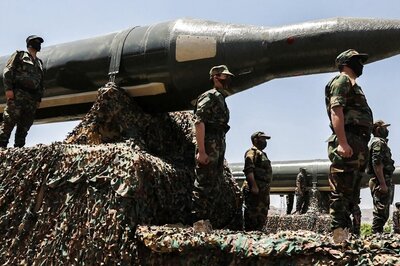
views
Miles away from the Kerala border, the flower merchants in Tamil Nadu's Tirunelveli are despondent. Onam season is when their flowers find a ready market in Kerala, to be part of the pookkalam or the flower carpets. An estimate of 800-odd tonnes of flowers — from marigold to jasmine to chrysanthemum — move into Kerala during the ten-day festival. This time, with roads affected by the floods and the landslides and cancellation of the Onam festivities, the flowers have no takers.
Tirunelveli is not the only market. Flowers are also sourced every year from Hosur, Coimbatore, Kanyakumari and Bengaluru. This time, Kerala's gloom has ensured there is no bloom in their flower business.
In terms of timing, the floods in Kerala could not have hit the state at a worse time. The rains shifted to a higher gear just around the time Kerala was preparing to get into Onam celebration mode. People cutting across all religions take part in the Onam festivities and this is the time when supermarkets and all big brands of white goods announce massive Onam sales, to encourage Keralites to splurge.
"Up to 15% of the turnover of say electronics and textile business comes from these two weeks before and during Onam. Supermarkets do excellent business during the festive season. This time, that has not happened," says TR Vijaykumar, President of the Chamber of Commerce in Thrissur.
The tourism industry, the backbone of Kerala's economy, was badly hit by the floods. With air traffic affected by the closure of the Cochin International airport, that handles most arrivals into Kerala, most tourists coming from outside the state cancelled their plans. The fancy tourist destinations of Alappuzha, Munnar, Kumarakom and Periyar were among the worst hit with over 95% cancellations.
"Roads have to be rebuilt, destinations have to be cleaned up and services have to be operational. It will take a couple of months to restart. Tourists also generally try and avoid a destination where local people are in distress," says EM Najeeb, Managing Director, Air Travel Enterprises.
The peak season for Kerala Tourism begins in October and the industry is keeping its fingers crossed to see if there will be many cancellations. In terms of revenue, August so far has seen the sector taking a 75 to 80% hit.
Since tourist packages in Kerala are also dovetailed into medical tourism, both the health and hospitality sector bore the brunt. Dr Sajikumar, MD of Dhatri Ayurveda who is also the President of the Kerala chapter of CII says 50% of medical tourism was immediately impacted.
"There has not been any new patient coming in from outside. This when 25 to 30% of our clientele is from abroad, largely from the Middle East. Activity over the next three months is likely to get affected as well," says Dr Sajikumar.
In its memorandum to the Prime Minister, the Kerala government pegged the losses to the state through damage to infrastructure and property at Rs 20,000 crore. The industry estimates the losses by way of loss of working days, cancellations and drop in economic activity at close to Rs 25,000 crore.
But what was heartening was that despite the financial offset, not everything was about money. Dr Harish Pillai, CEO of Aster Hospitals and Clinics, recalls how they evacuated 350 patients from their largest hospital in Kochi on 16 August because they feared it will get flooded as it was located in a low-lying area.
"But over the next four days, all our 80 doctors and 150 nurses were deployed in 20 relief camps, helping government hospitals in Kochi and Kalamassery. This was made possible with the district authorities along with the Indian Medical Association forming a nerve centre, with private sector joining hands with the government," says Pillai.
For the medical sector, this is the second big challenge this year. Their energies were focused on battling the Nipah virus earlier this year.
But there is also a silver lining in the dark clouds. The process of rehabilitating people back in their homes will also involve in most cases starting life from scratch. With most homes flooded, families would need to invest in white goods and that would, the industry hopes, lead to a rejuvenation of the local economy. Also, the real estate and reconstruction sector will see a fast pace of activity that is further likely to generate employment and boost growth.
Reconstructing Kerala isn't a task that will get done in a hurry. Kerala Returns is a sequel that will take some out of the box thinking and hard work.
(The writer is a senior journalist. Views expressed are personal.)



















Comments
0 comment